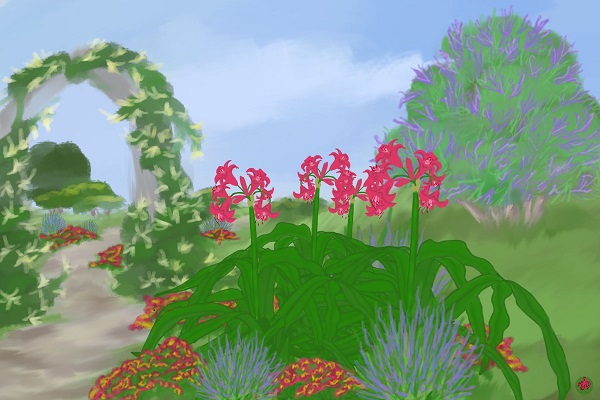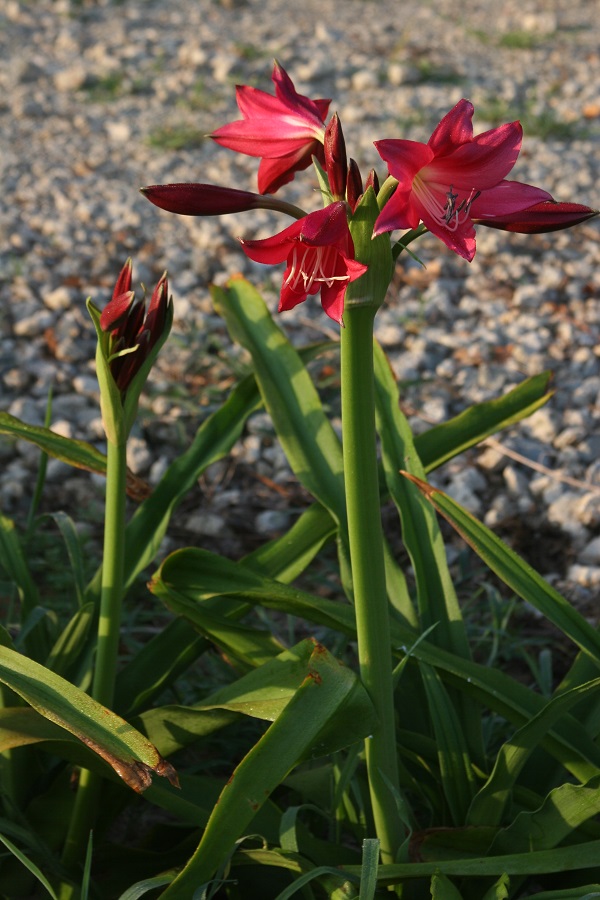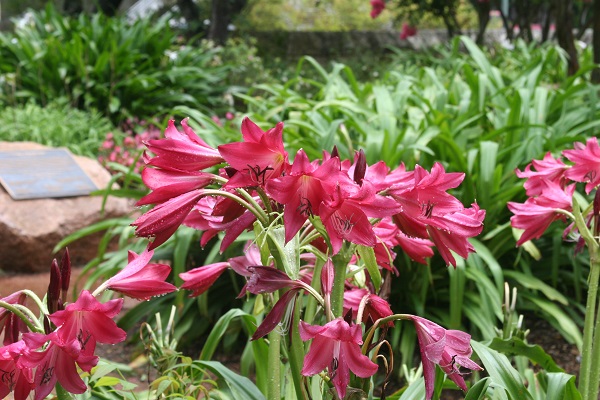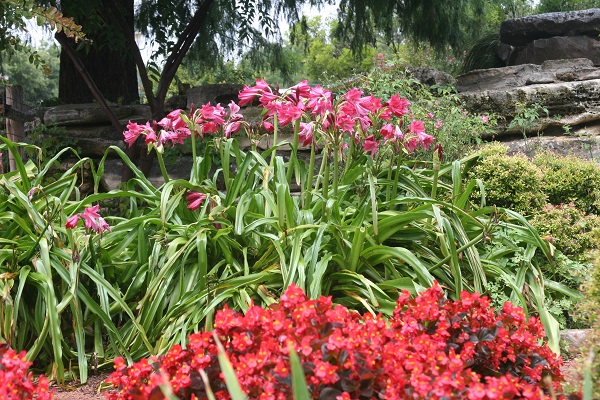


These crinum are extremely tough bulbs that offer deep pink flowers during the hottest parts of our summer months. They are valued for their color and their ability to stand up and keep their form in the heat. It is a must for any traditional Southern garden as it makes a magnificent centerpiece of color and structure for summer gardens! We hope you enjoy them!
Horticuluralist, Greg Grant says, "I don't know of any plant which has been ignored by modern gardeners of the South to the extent that crinums have. There is probably no other flowering perennial which can be classed as both extremely drought tolerant and aquatic, while providing stunning displays of fragrant, cut flower quality blossoms. If you have them, appreciate them, becaue they are truly unique Southern perennials."

Blooms: They produce numerous blooms that stand atop strong erect stalks about 3-4 feet tall. Each stalk has multiple 3-5" trumpet blooms that look great left in the garden or cut and brought in the house for bouquets. Depending on the lighting, the blooms look deep pink to almost burgandy.
It will begin blooming in mid-June. Even in the heat of the day in June and July, it will keep its form and proudly stand tall. Blooming is heaviest during June, but older, well-established crinum can continue to blossom on and off for the rest of the summer. It makes a beautiful cut-flower centerpiece with its spicy fragrance.
The crinum may be the shyest bulb to bloom. But, you can expect three great things from the crinum:
1) Nice, dark green foliage the first year planted in its new place of planting. This foliage lasts most of the year.
2) Robust, repeat blooms that are show-stoppers in 2-3 years. After blooming for the first time, no more waiting. You will have excellent blooms each following year.
3) Bulb multiplication. Crinum naturalize well with bulb offsets and form large, mature clumps of lush crinum foliage and blooms 4 to 7 years after planting.
You can rest assured that if the bulb is firm to the touch, then it is healthy and will come up. Flower bulb foliage naturally dies back when they are dug, and crinum flower bulb foliage will die back with the first freeze of the season. this is a natural, healthy process! Depending on when you plant your crinum bulbs, it can be at least 6 months before you see any foliage.

Planting:
The Crinum 'Ellen Bosanquet' can add that POP of color to your summer garden with big showy deep pink blooms in June that make everyone pause to look. This crinum has proven itself to produce and flourish in the hot southern summers even in zone 10, and it works great as far north as zone 7 where it survives the cold. Summer months often bring vacations. We all want flowers during the summer but are concerned about them surviving the heat and no water if we go off and leave them. The Crinum 'Ellen Bosanquet' are hardy and do well while you are away.
The Crinum 'Ellen Bosanquet' lily does best when it can receive at least 8 hours of sun (an entire day is preferred) each day. Crinums like to be planted in moist well-drained soil. Plant the bulb with the neck of the bulb above the soil. In other words, the bulk of the bulb, which is more round, needs to be completely covered in dirt to protect the bulb from the sun in the summer and the cold in the winter, but the longer neck is normally exposed above the soil line.

Foliage: The 'Ellen Bosanquet' has lush green foliage that quickly fills an area while the blooms shoot up on stems about 3-4 feet tall. The 'Ellen Bosanquet' will make a show in your garden so be sure to give them some room to multiply and grow.

Landscape and Maintenance: Perhaps one of the most successful landscape uses of Crinum 'Ellen Bosanquet' I have witnessed was at the public gardens in Fredericksburg, TX. There, some astute landscape planner had used them en masse in combination with wax leaf begonias. In addition to their blooms, they are tough bulbs that can survive hi traffic public areas. I've included a picture from this right above.
Crinum really shine in the garden when they are used with other companion plants. In our personal gardens, we use them with a skirting of salvia, lantana, or summer blooming phlox. This year I used a lower growing white meadow sage (Salvia nemerosa) even though a part of me loves combining them with larger and somewhat wilder looking Salvia leucantha. We have a battle in our garden over "nice and tidy" plants vs. others that have a little less form. The tight and compact Salvia nemerosa has helped bring more structure to my crinum plantings and satisfied both gardening parties!
History and fun facts:
The Crinum 'Ellen Bosanquet' has been around for over 100 years which isn't as old as some of our bulbs, but it has proven its value in the hot southern summers.
The name is actually pronounced -- Boz - an - ket or Boz - an - kwet. He was English not French.
The story of the Crinum 'Ellen Bosanquet' lily is quite the mystery, with little known about the flower's origin. It was originally hybridized by Louis Bosanquet, a Floridian who had a penchant for crinum lilies and spent many years of his life creating new colors and forms of the plant.
Somewhere between 1915 and 1920, he crossed a variation of crinums to create an enchanting hybridization with reddish-purple flowers supported by tropical green foliage. He loved them so much that he named them after his wife, Ellen Bosanquet. To this date the exact crosses he made are unknown, and no one has been able to reproduce this Crinum lily in over 100 years of attempts.

These crinum are extremely tough bulbs that offer deep pink flowers during the hottest parts of our summer months. They are valued for their color and their ability to stand up and keep their form in the heat. It is a must for any traditional Southern garden as it makes a magnificent centerpiece of color and structure for summer gardens! We hope you enjoy them!
Horticuluralist, Greg Grant says, "I don't know of any plant which has been ignored by modern gardeners of the South to the extent that crinums have. There is probably no other flowering perennial which can be classed as both extremely drought tolerant and aquatic, while providing stunning displays of fragrant, cut flower quality blossoms. If you have them, appreciate them, becaue they are truly unique Southern perennials."

Blooms: They produce numerous blooms that stand atop strong erect stalks about 3-4 feet tall. Each stalk has multiple 3-5" trumpet blooms that look great left in the garden or cut and brought in the house for bouquets. Depending on the lighting, the blooms look deep pink to almost burgandy.
It will begin blooming in mid-June. Even in the heat of the day in June and July, it will keep its form and proudly stand tall. Blooming is heaviest during June, but older, well-established crinum can continue to blossom on and off for the rest of the summer. It makes a beautiful cut-flower centerpiece with its spicy fragrance.
The crinum may be the shyest bulb to bloom. But, you can expect three great things from the crinum:
1) Nice, dark green foliage the first year planted in its new place of planting. This foliage lasts most of the year.
2) Robust, repeat blooms that are show-stoppers in 2-3 years. After blooming for the first time, no more waiting. You will have excellent blooms each following year.
3) Bulb multiplication. Crinum naturalize well with bulb offsets and form large, mature clumps of lush crinum foliage and blooms 4 to 7 years after planting.
You can rest assured that if the bulb is firm to the touch, then it is healthy and will come up. Flower bulb foliage naturally dies back when they are dug, and crinum flower bulb foliage will die back with the first freeze of the season. this is a natural, healthy process! Depending on when you plant your crinum bulbs, it can be at least 6 months before you see any foliage.

Planting:
The Crinum 'Ellen Bosanquet' can add that POP of color to your summer garden with big showy deep pink blooms in June that make everyone pause to look. This crinum has proven itself to produce and flourish in the hot southern summers even in zone 10, and it works great as far north as zone 7 where it survives the cold. Summer months often bring vacations. We all want flowers during the summer but are concerned about them surviving the heat and no water if we go off and leave them. The Crinum 'Ellen Bosanquet' are hardy and do well while you are away.
The Crinum 'Ellen Bosanquet' lily does best when it can receive at least 8 hours of sun (an entire day is preferred) each day. Crinums like to be planted in moist well-drained soil. Plant the bulb with the neck of the bulb above the soil. In other words, the bulk of the bulb, which is more round, needs to be completely covered in dirt to protect the bulb from the sun in the summer and the cold in the winter, but the longer neck is normally exposed above the soil line.

Foliage: The 'Ellen Bosanquet' has lush green foliage that quickly fills an area while the blooms shoot up on stems about 3-4 feet tall. The 'Ellen Bosanquet' will make a show in your garden so be sure to give them some room to multiply and grow.

Landscape and Maintenance: Perhaps one of the most successful landscape uses of Crinum 'Ellen Bosanquet' I have witnessed was at the public gardens in Fredericksburg, TX. There, some astute landscape planner had used them en masse in combination with wax leaf begonias. In addition to their blooms, they are tough bulbs that can survive hi traffic public areas. I've included a picture from this right above.
Crinum really shine in the garden when they are used with other companion plants. In our personal gardens, we use them with a skirting of salvia, lantana, or summer blooming phlox. This year I used a lower growing white meadow sage (Salvia nemerosa) even though a part of me loves combining them with larger and somewhat wilder looking Salvia leucantha. We have a battle in our garden over "nice and tidy" plants vs. others that have a little less form. The tight and compact Salvia nemerosa has helped bring more structure to my crinum plantings and satisfied both gardening parties!
History and fun facts:
The Crinum 'Ellen Bosanquet' has been around for over 100 years which isn't as old as some of our bulbs, but it has proven its value in the hot southern summers.
The name is actually pronounced -- Boz - an - ket or Boz - an - kwet. He was English not French.
The story of the Crinum 'Ellen Bosanquet' lily is quite the mystery, with little known about the flower's origin. It was originally hybridized by Louis Bosanquet, a Floridian who had a penchant for crinum lilies and spent many years of his life creating new colors and forms of the plant.
Somewhere between 1915 and 1920, he crossed a variation of crinums to create an enchanting hybridization with reddish-purple flowers supported by tropical green foliage. He loved them so much that he named them after his wife, Ellen Bosanquet. To this date the exact crosses he made are unknown, and no one has been able to reproduce this Crinum lily in over 100 years of attempts.